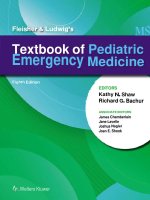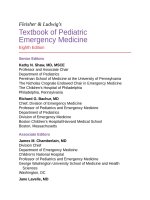Pediatric emergency medicine trisk 0313 0313
Bạn đang xem bản rút gọn của tài liệu. Xem và tải ngay bản đầy đủ của tài liệu tại đây (71.02 KB, 1 trang )
care quickly. Ideally, advanced pediatric care begins the moment the transport
team is contacted. Pediatric medical or surgical advice, before the arrival of the
transport team, can be stabilizing and potentially lifesaving for the patient.
Finally, in geographic locations where specialized pediatric transport is
unavailable, involvement of skilled acute care/critical care pediatricians on the
referring and/or receiving end is extremely important.
A final consideration is when transport across international borders is
indicated. This mode of transport requires significant preplanning. Specific issues
to be considered for these patients include language of providers (and patients),
compatibility and redundancy of medical equipment, power sources, medication
issues with customs, communications during transport, visas, passports, parental
consent for a patient to leave the country, documentation, and logistics of
transport durations. For many international, long-distance transports, air crews are
required to “time out,” necessitating transport times that may require multiple
days, or use of additional personnel for the transport. Similar work rule
considerations, although perhaps not as rigid as established Federal Aviation
Administration (FAA) crew requirements, should be afforded to the transport
healthcare personnel. Options and solutions to these issues are available, but must
be anticipated prior to need. Several services specialize in international
transports; these services are useful consultants for teams less familiar with
international transports.
MODES OF TRANSPORT
When a decision is made to transport a pediatric patient, there is often a
discussion on the appropriate mode of transport. Nonmedical modes of transport
include a parent’s automobile or a taxicab. Problems with those options include
lack of assurance of direct transport to the receiving facility, inability to ensure
patient safety, and the lack of available medical care during the transfer. Even the
accompaniment of a physician or nurse does not markedly improve the ability for
medical intervention in these nonmedical vehicles. A Basic Life Support (BLS)
ambulance offers direct transportation to the receiving institution, but does not
offer much in the way of pediatric expertise or intervention capability. Physician
or nurse accompaniment in a BLS ambulance increases potential level of medical
care, however the BLS environment is limited with regard to standard personnel,
pediatric equipment, and medications. ALS transport offers more sophisticated
resuscitation abilities, including intubation equipment, vascular access
capabilities, and medication administration for adult and pediatric patients. These
ALS interventions are generally guided by state and region-specific regulations.









